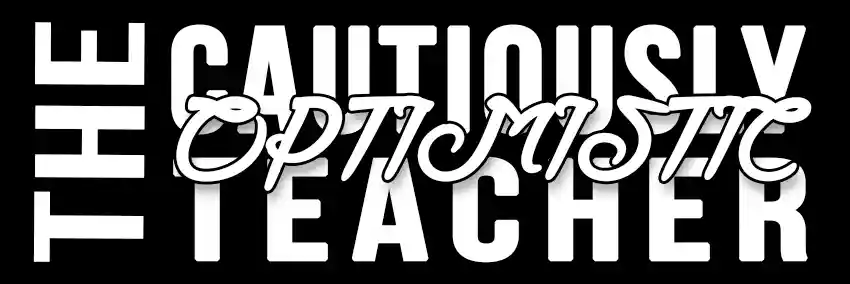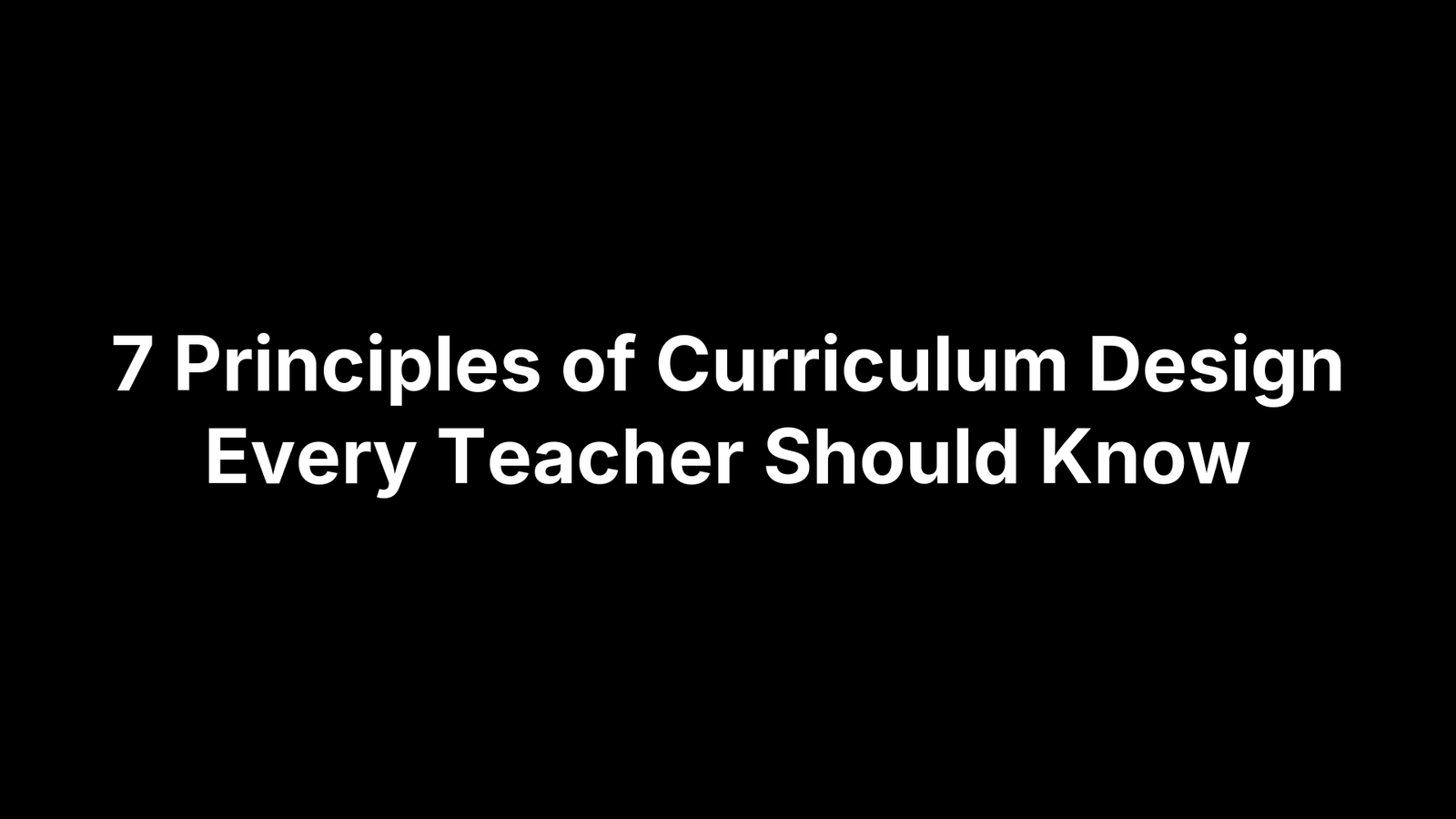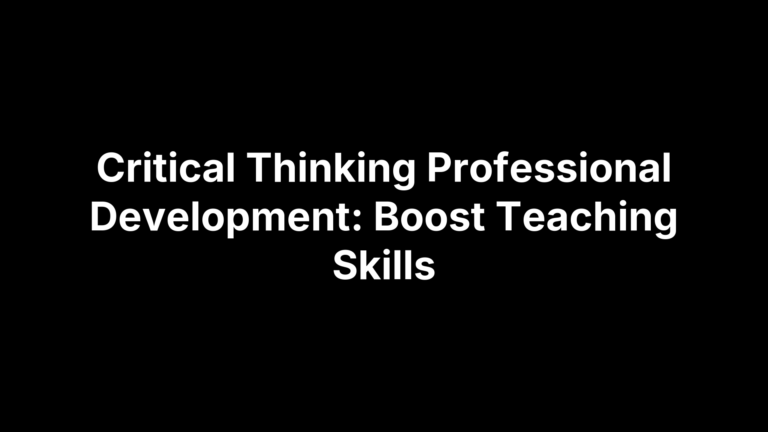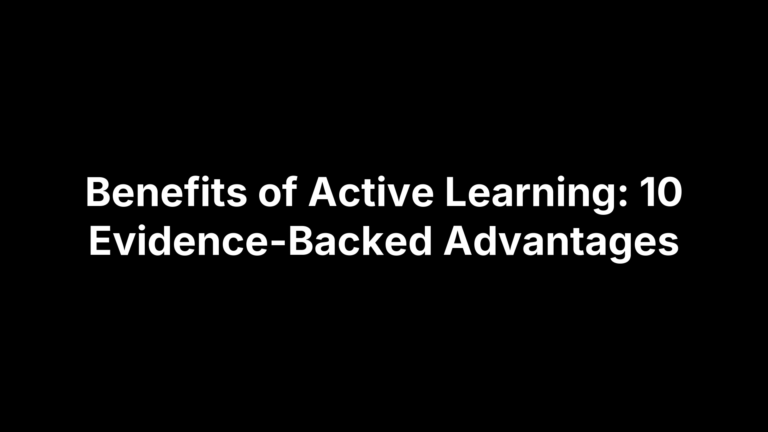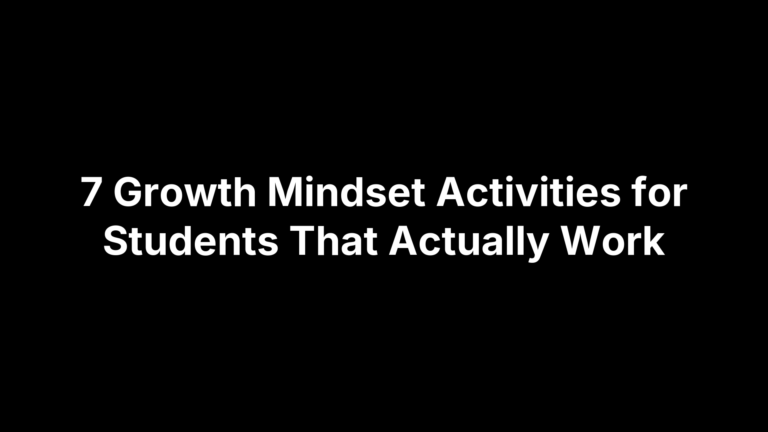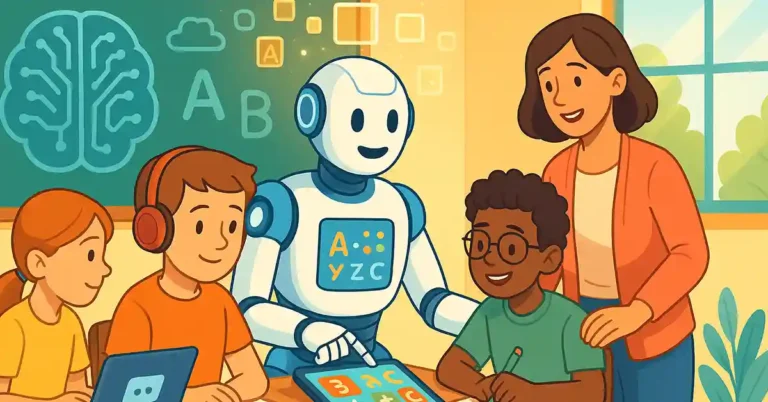Principles of Curriculum Design: A Practical Guide for Classrooms
Challenge & enjoyment, breadth, progression, depth, personalisation & choice, coherence, and relevance form the seven principles of curriculum design that have guided Scottish education since Curriculum for Excellence and are now inspiring teachers worldwide. More than buzzwords, they give any class—whether kindergarten phonics or AP Calculus—a sturdy skeleton on which meaningful learning can grow. They are equally useful for veteran educators revisiting a tired syllabus and new teachers crafting their first unit.
When you understand these principles you can plan units that hit standards without hitting burnout, align assessments with learning goals, and guarantee every student meets high expectations while still having a reason to smile. The pages ahead unpack each principle in four quick stops: what it means, why it matters, classroom-ready strategies, and common pitfalls. We close with a step-by-step roadmap and grab-and-go checklist so you can begin refining tomorrow’s lesson before the bell rings. Ready to tighten your curriculum toolkit? Let’s begin.
1. Challenge and Enjoyment: Making Learning Rigorous Yet Fun
When a unit hums with both intellectual stretch and genuine delight, students hit that sweet spot where effort feels worthwhile. Challenge & enjoyment is the first—and arguably most memorable—of the seven principles of curriculum design because it reminds us that rigor is pointless if students dread every minute.
What “Challenge and Enjoyment” Really Means
Think Vygotsky’s ZPD meets Csikszentmihalyi’s flow channel: tasks sit just beyond current ability but are scaffolded enough to keep frustration low and curiosity high. The principle emphasizes high expectations, visible progress, and emotional payoff, all shown to bolster well-being and long-term achievement.
Practical Strategies to Embed Rigor with Joy
- Gamify formative checks: digital badge systems, “escape room” quizzes, or leaderboard-free goal boards for quieter classes.
- Tiered tasks (
must-do / should-do / could-do) so every learner tackles an achievable stretch. - Inquiry or project-based learning that starts with a puzzle students actually want to solve.
- Quick “choice sparks” at lesson openings—two problem variants, students pick which to tackle.
- Celebrate productive struggle with mini-reflections: “What tripped me up—and how I beat it.”
Common Pitfalls and How to Avoid Them
- Piling on difficulty without scaffolds; use worked examples and peer coaching.
- Isolating fun in “Free-choice Friday”; weave enjoyment into daily routines.
- Assuming all students share one definition of fun—survey interests and rotate formats.
Purposeful balance keeps the challenge motivating, not immobilizing.
2. Breadth: Ensuring a Wide Base of Knowledge and Skills
A broad curriculum guarantees students encounter a rich mix of concepts, disciplines, and tools before they specialize. It guards against the echo chamber effect—when kids double down on what they already like and miss out on the perspectives that make them agile thinkers.
Defining Breadth in an Overcrowded Curriculum
Breadth means horizontal coverage across strands, skills, and subject areas, not an indiscriminate content dump. Ask, “What essential knowledge from math, literacy, the arts, and STEM must every learner sample by year’s end?” Align those essentials with standards, then trim duplicate or obsolete topics to prevent bloating.
Planning Techniques for Breadth
- Curriculum-mapping grid: list standards down the rows, big ideas across the columns; highlight gaps and overlaps.
- Spiral review: schedule quick revisits so ideas re-appear in fresh contexts.
- Integration weeks: let science, social studies, and ELA converge on a unifying theme—say, water scarcity—so students see connections.
- Quick content audits each quarter: if one domain hogs the calendar, rebalance.
Assessing Breadth Without Teaching “a Mile Wide, Inch Deep”
- Cross-subject performance tasks (e.g., design a sustainable playground requiring geometry, ecology, and persuasive writing).
- Student portfolios where artifacts come from at least three disciplines.
- Self-audit checklists: learners tick off skills and knowledge areas they’ve practiced, highlighting any blind spots.
Rich evidence like this shows whether the principle of breadth—central to the wider principles of curriculum design—has actually materialized in student experience.
3. Progression: Building Learning Step by Step
Progression is the engine that moves a class from “I’ve heard of it” to “I own it.” While breadth spreads knowledge, progression arranges that knowledge in a purposeful climb so students can tackle increasingly complex tasks without falling off the mountain.
Why Progression Is More Than Sequencing
A mere order of lessons isn’t enough; each experience must activate prior understanding, extend it, and preview what’s next. Think Bloom’s or SOLO taxonomy in action—students first recall, then connect, then create. Without this deliberate scaffolding, isolated “one-off” lessons leave cognitive potholes that stall later learning and undercut the larger principles of curriculum design.
Tools to Plan for Progression
- Learning-progression charts: break big standards into micro-skills (e.g.,
interpret data ➔ compare data sets ➔ critique methodology). - Pre-assessment probes and hinge questions at key junctions to decide whether to reteach or accelerate.
- Backward design: sketch the summative task, then plot the prerequisite knowledge backwards to today’s mini-lesson.
This triad keeps the route clear and prevents detours into content that doesn’t serve the end goal.
Monitoring & Communicating Progression
Make growth visible. Use classroom data walls, digital dashboards, or color-coded trackers that show each learner’s current rung. Hold quick goal-setting conferences so students can articulate, “I’m moving from analyzing to evaluating.” When learners see the staircase, they’re far more willing to climb it.
4. Depth: Cultivating Mastery and Higher-Order Thinking
Speed-reading through a unit may keep you “on schedule,” yet it rarely engraves concepts in long-term memory. The depth principle asks us to slow the roll—giving students enough cognitive dwell time to connect ideas, test theories, and reflect. Neurological studies on retrieval practice and elaborative interrogation show that deliberate struggle followed by consolidation wires knowledge for keeps, turning recall into flexible transfer.
The Difference Between Coverage and Deep Learning
Coverage races through content so learners can recognize terms on a quiz. Deep learning lets them use those terms in unfamiliar contexts. It hinges on meaningful processing: students elaborate, question, argue, and revisit material. The payoff is durable understanding and the confidence to tackle novel problems—an outcome every set of principles of curriculum design ultimately seeks.
Instructional Strategies for Depth
- Socratic or Harkness discussions that demand evidence-based thinking.
- Hexagonal thinking: arrange concept cards, then justify each adjacency to surface relationships.
- Concept mapping followed by “teach-back” mini-lessons.
- “Slow checking” protocols: students solve complex problems, then annotate each step for accuracy and reasoning.
- Multi-source investigations—articles, datasets, and primary documents—to cultivate synthesis.
Avoiding Shallow Learning Traps
- Limit endless low-level worksheets; swap in tasks that require analysis or creation.
- Build reflection pauses into pacing guides so units don’t become a conveyor belt.
- Diversify resources—texts, media, experts—to prevent single-story thinking.
A deep curriculum is not a longer one; it’s a deliberately carved path where every activity earns its keep toward mastery.
5. Personalisation and Choice: Putting Students in the Driver’s Seat
Students learn best when they can see themselves—and their interests—in the work. The principles of curriculum design highlight personalisation and choice because autonomy fuels engagement while allowing teachers to meet diverse needs without lowering expectations.
Why Personalisation Boosts Motivation and Achievement
Self-Determination Theory says autonomy, competence, and relatedness turbo-charge intrinsic motivation. When learners select a text set on climate fiction or decide whether to show mastery through a podcast or a data visualization, they invest more effort and persist longer. Research on growth mindset and differentiation also shows that personalized pathways close achievement gaps by honoring starting points and stretching every student.
Design Methods for Personalisation
- Choice boards or learning menus offering tiered tasks aligned to the same standard
- Flexible grouping that shifts after each formative check, not just once a term
- Adaptive tech tools—like an AI-driven differentiated instruction helper—that adjust reading level or problem type in real time
- Interest surveys to seed project topics or independent reading lists
Balancing Freedom with Curriculum Goals
Guardrails matter. Post non-negotiable learning outcomes, then let students pick the route. Act as curator and coach: suggest resources, co-create rubrics, and schedule quick conferences to ensure choices still hit the mapped objectives. Autonomy plus accountability keeps creativity high and standards intact.
6. Coherence: Creating a Seamless Learning Journey
Few things fray student confidence faster than a curriculum that feels like random puzzle pieces from different boxes. Coherence ties every lesson, unit, and assessment into a clear storyline so learners always know why today’s work matters and how it links to yesterday’s and tomorrow’s. Among the principles of curriculum design, it’s the connective tissue that prevents whiplash and boosts retention.
What Coherence Looks Like in Practice
- Vertical alignment: Grade 4 fractions set the stage for Grade 5 ratios, which flow into Grade 6 proportions.
- Horizontal alignment: An English debate on water rights syncs with science labs on the water cycle.
- Constructive alignment: Objectives, activities, and assessments all measure the same skill, avoiding “teach one thing, test another.”
Frameworks and Tools to Achieve Coherence
- Unit‐overview matrix: columns for key questions, skills, texts, and assessments reveal gaps at a glance.
- Essential-question threads: revisit a big idea (e.g., “What makes a fair society?”) across subjects and semesters.
- Team planning protocols: shared Google Docs or PLC meeting templates keep departments on the same page.
Detecting and Fixing Incoherence
- Storyboard the unit—does each “scene” advance the plot?
- Poll students: “Can you explain how today’s lesson links to last week’s?”
- Conduct pacing-guide audits; cut redundancies, reorder lessons, or add bridging activities to smooth the narrative.
7. Relevance: Connecting Learning to Real Life
Even the most coherent, challenging unit can flop if students fail to see why it matters once the bell rings. Relevance grounds the other principles of curriculum design in lived experience, turning abstract standards into tools for navigating community issues, careers, and personal passions. When learners sense that today’s lesson might improve tomorrow’s world, attention spikes and misconceptions surface for correction.
Why Relevance Energizes Engagement and Transfer
Brain imaging studies show that emotionally charged, personally significant tasks activate dopaminergic pathways that strengthen memory traces. Practically, a statistics lesson framed around local housing costs sticks longer than one about hypothetical widgets. Authentic contexts also promote far transfer—the ability to apply knowledge in unfamiliar settings—because students store ideas alongside real-world cues they will encounter again.
Strategies to Make Content Relevant
- Invite authentic audiences: publish essays on the town website or present prototypes to industry mentors.
- Integrate case studies linked to current events students already discuss at lunch.
- Forge community partnerships—city planners, NGOs, local artists—to supply genuine problems and datasets.
- Use problem- and place-based learning: map neighborhood walkability, test water quality, or analyze school energy bills.
- Provide choice in application formats—podcasts, social media campaigns, policy briefs—so learners connect curriculum to personal interests.
Safeguards to Ensure Genuine Relevance
Keep references purposeful, culturally responsive, and up-to-date. Avoid gimmicky pop culture shoe-horns; instead, co-check examples with students each term to confirm they still resonate and respectfully reflect diverse identities.
8. From Principles to Practice: A Step-by-Step Implementation Roadmap
Reading about the seven principles is one thing; weaving them into day-to-day planning is another. The five steps below turn theory into an iterative workflow you can start during your next prep period and refine over time.
Step 1 – Establish Clear Curriculum Aims Aligned to the 7 Principles
Draft or revisit a vision statement and learner profile that explicitly references challenge, breadth, progression, depth, personalisation, coherence, and relevance. These anchors keep later decisions—resources, pacing, assessment—pointed in the same direction.
Step 2 – Audit Your Current Curriculum
Run a quick gap analysis: list units down one column, the seven principles across the top, then note evidence, missing elements, and quick wins. Patterns jump out fast: overloaded breadth, shaky coherence, or thin relevance.
Step 3 – Design or Redesign Units Using Backward Design + Principles Checklist
Start with the desired summative performance, scaffold backward, and check plans against the universal design questions below.
| # | Principles Checklist Item |
|---|---|
| 1 | Identify issue / learner need |
| 2 | State intended outcomes |
| 3 | Select essential content |
| 4 | Plan engaging delivery methods |
| 5 | Embed resources & tech |
| 6 | Sequence for progression |
| 7 | Build in depth opportunities |
| 8 | Provide personalisation pathways |
| 9 | Align assessments for coherence |
| 10 | Review & evaluate for relevance |
Print, laminate, and keep it beside your laptop.
Step 4 – Pilot, Gather Data, and Iterate
Trial the redesigned unit in one class. Collect hinge-question scores, portfolio samples, and student voice surveys. Debrief with a colleague, tweak scaffolds, and note which principles need stronger evidence.
Step 5 – Scale and Sustain
Share successes in PLCs, schedule coaching cycles, and repeat the audit every semester. Small, steady iterations embed the principles of curriculum design into school culture without overwhelming staff or students.
9. Key Takeaways for Designing Your Next Unit
Designing a unit that sings means treating the seven principles as interlocking gears, not isolated checkboxes. Start by tuning “Challenge & Enjoyment” so students feel the productive buzz of hard fun. Check that “Breadth” exposes them to varied ideas, then arrange those ideas in a clear “Progression” that climbs toward mastery. Pause for “Depth,” letting learners wrestle with concepts until they stick, and weave in “Personalisation & Choice” so every student owns the journey. Use “Coherence” to stitch lessons, assessments, and subjects into one storyline, and anchor everything in “Relevance” to life beyond school. Ready to put theory into action? Grab the free planning templates and AI-powered helpers waiting on The Cautiously Optimistic Teacher and start upgrading tomorrow’s lesson today.
